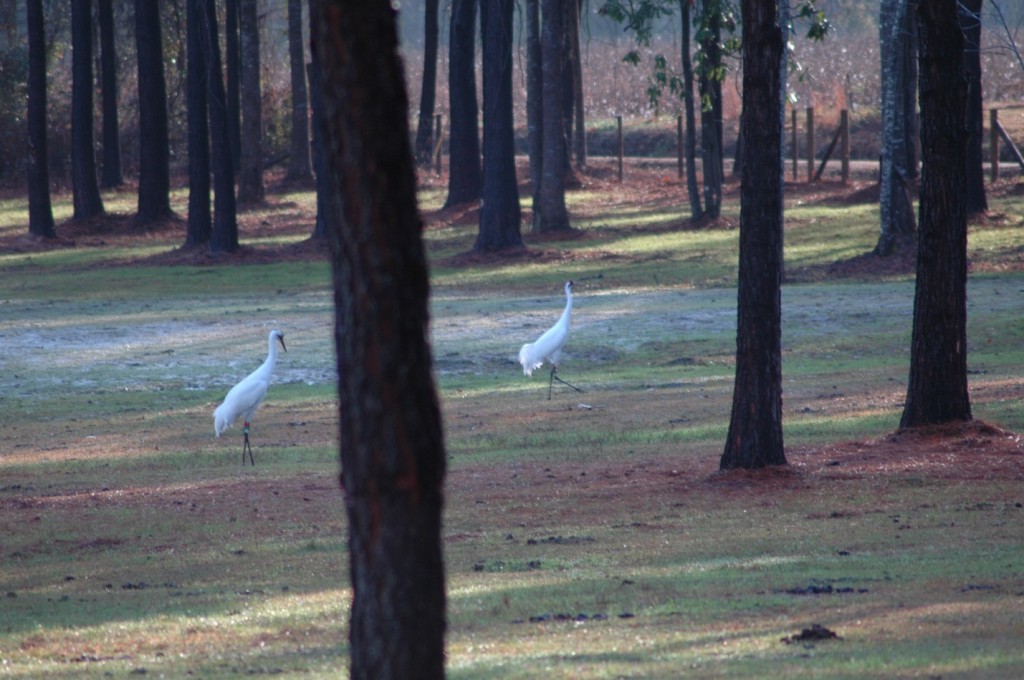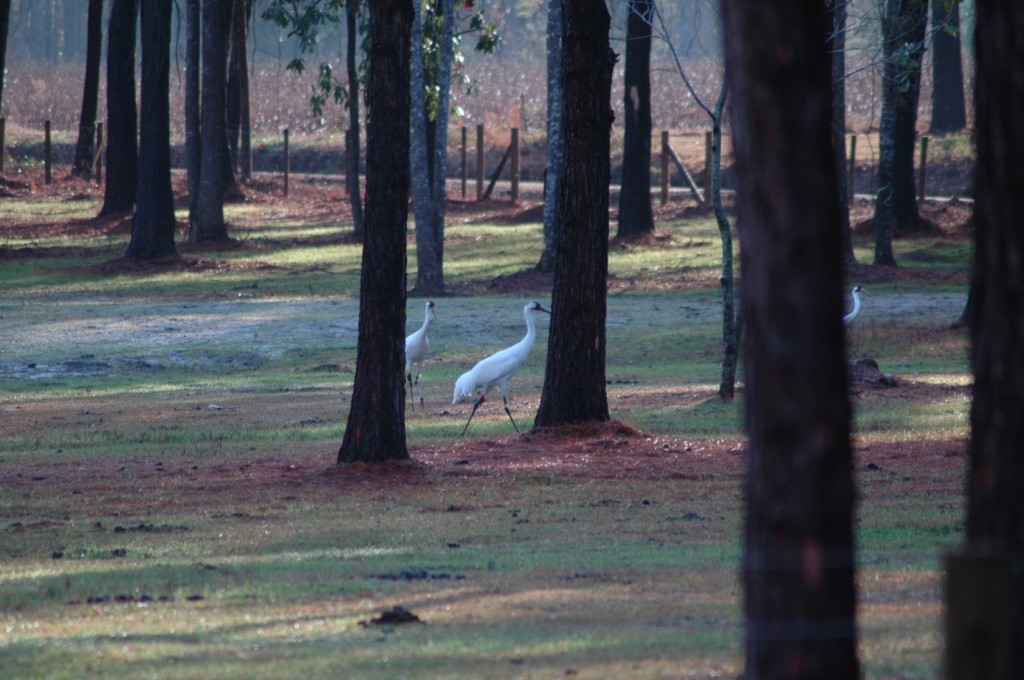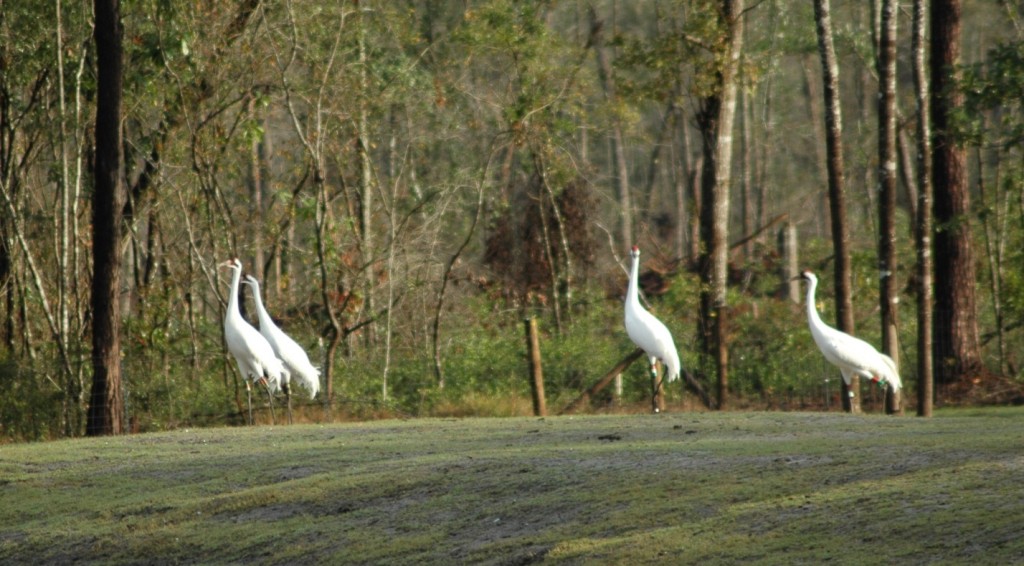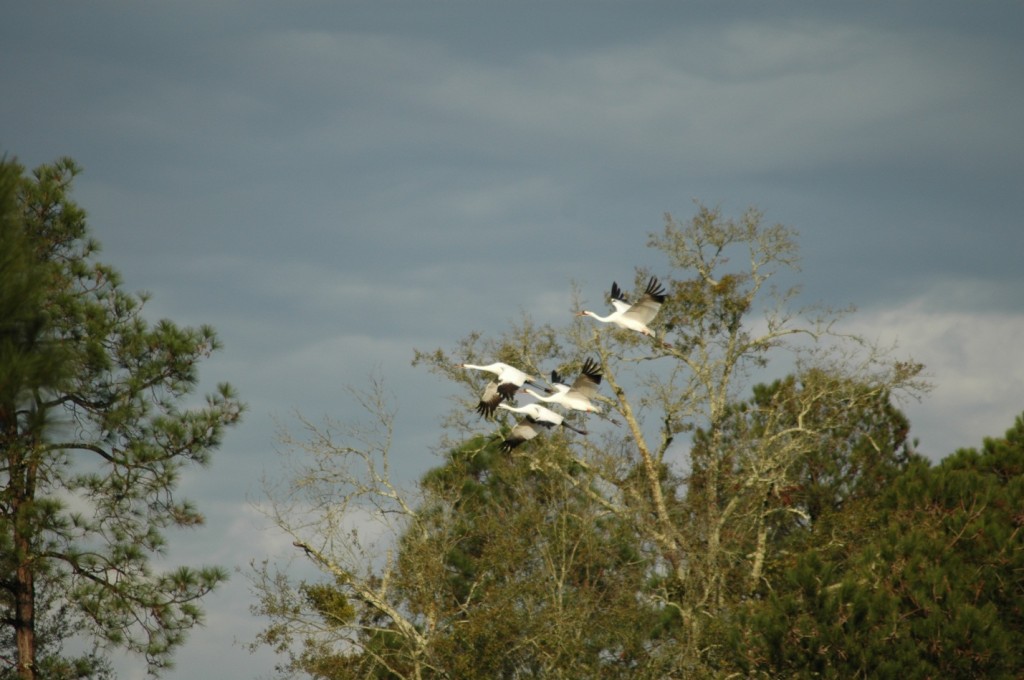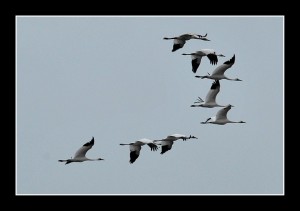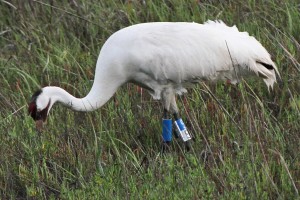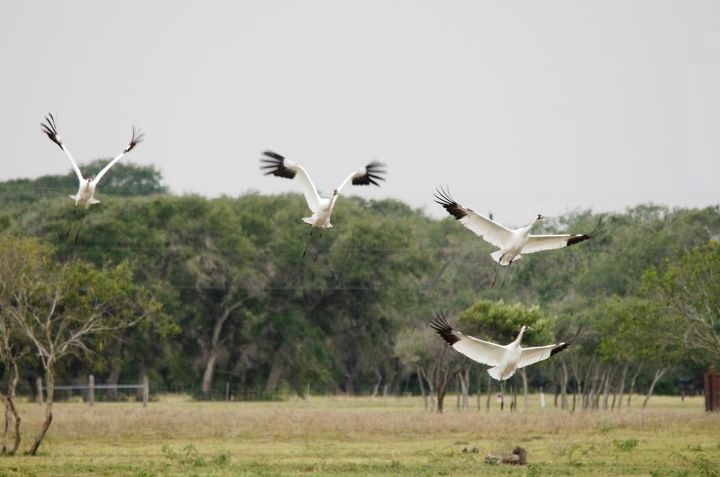Archive for the ‘Census Flights’ Category
A WHOOPER NEW YEAR TO ALL
December 27, 2012by Chester McConnell
The Whooping Crane Conservation Association wishes Operation Migration, Florida, Louisiana, International Crane Foundation, U.S. Fish and Wildlife Service and all of our citizen supporters a Whooper Happy New Year. We hope for continued success of the several whooping crane programs. All our combined efforts are essential to help reach the goals described in the International Recovery Plan for the Whooping Crane.
Each private organization and agency has its own program but another very important element to the success of all programs is the tremendous contributions of the private citizens. They assist us in many ways including moral support, contributions of dollars, spreading the message and reporting observations. I want to give recognition to a special group of citizens who observe whoopers and take the time to report their sightings.
The Whooping Crane Conservation Association’s web site includes a “Report A Sighting” section where anyone can let us know about their observations of whooping cranes. We receive reports from many states and several provinces in Canada. While the vast majority of the reports are accurate a few actually turn out to be other large white birds with black wing tips (such as wood storks, white pelicans, snow geese, white ibis) or sand hill cranes. Mostly those who report their sightings have first gone to our web page “Identification” section to convince themselves that they have made a correct identification.
During the past year we have received about 130 reports of whooping crane sightings. About 100 reports involved birds from the Aransas/Wood Buffalo (Western) flock. These reports came from persons in 7 central states and 2 Canadian provinces. And about 30 were sightings of cranes from the Operation Migration (Eastern) program. These reports came from 12 eastern states. If a report seems questionable, we discuss the observations with those who made the report. We believe that about 90 percent of the citizen reports are accurate.
The information received is useful in monitoring the migration of the cranes and determining the locations of some of the individuals at a point in time. Of course some of the cranes are counted more than once because they move often during migration.
An added benefit from the citizen spotters is that some of them send us interesting photos and videos of their observations. We recently received an interesting video and some unusual photos from one of those wonderful people who report their observations of whooping cranes to us. I requested and received permission from Cindy P….. to share with you her video and photos of whooping cranes on her property in Georgia. Her email description of her experience follows:
“Hi Chester,
Of course you may use any of the photos/audio that I shared with you for your website.
On December 17, 2012 at about 7:30 am, one pair of cranes arrived near our 3 acre pond. They grazed and walked about the property and within the next hour another pair of cranes appeared. I grabbed my camera and lenses along with my iphone and headed towards the pond. The four birds casually walked around the pond nibbling here and there. They walked all the way up towards the pine trees where I was able to photograph them using a telephoto lens. I was careful not to get too close to them (you can see in the audio/video how far away they were) so that I wouldn’t scare them off. They continued calling and browsing around for a couple of hours. I was ecstatic!”
“The next two days, the cranes came in and stayed for about thirty minutes before they flew due south. I have to say that they were absolutely gorgeous and I only wish I could have gotten closer. I took a great photo of them flying away. I live about 2 hours from St. Marks, Florida. I think these birds belonged to the flock that migrates that way each year. Hope you enjoy the pictures as much as I did making them. Merry Christmas to all….
Cindy P…. GA
To observe Cindy’s video click on the following: https://www.dropbox.com/s/hei3j65ty422v5k/WhoopCranesCalling.MOV
Several of Cindy’s photos are pasted below. Enjoy.
Being very catious. 12-17-2012
Migrating on south. 12-17-2012
MORE PHOTOS, READ ON:
Now, you can enjoy more whooper photos from more of our citizen reporters by clicking on the fol;lowing link: https://whoopingcrane.com/wp-content/uploads/2012/11/Whooper-photos-8-for-web-article-11-29-124.pdf
CELEBRATE WHOOPERS RETURN TO ARANSAS
December 1, 2012by Chester McConnell, Whooping Crane Conservation Association
All but a few whooping cranes have made it back to Aransas Refuge, Texas from their nesting area in Wood Buffalo National Park, Canada. The other birds are expected to arrive at their winter home on Aransas soon. Some are taking a respite at several locations, including Granger Lake, about 150 miles north of the refuge.
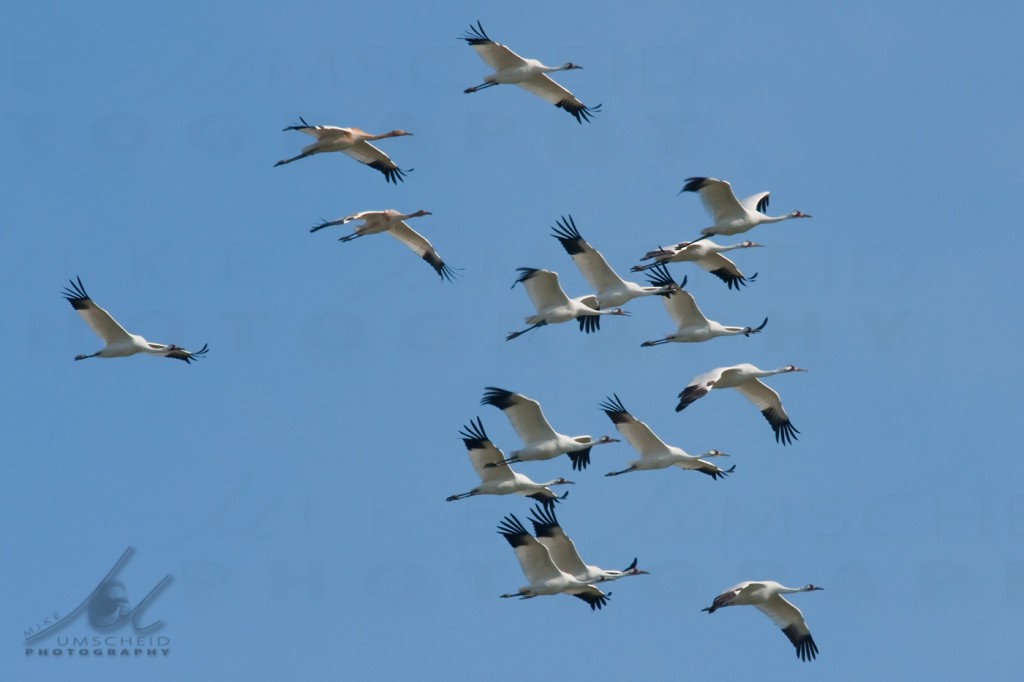
Sixteen whooping cranes migrating south towards Aransas National Wildlife Refuge, Texas. Photo by: Mike Umscheid
(For posters of the photo click: http://www.mikeumscheidphotography.com/title.php?n=SixteenWhooping&m=poster
The 2,400 mile migration trek from Wood Buffalo to Aransas has taken place for thousands of years and is cause for celebration by us humans. We celebrate because whooping cranes are increasing in numbers after facing extinction in the 1940s – 50s. The total flock had reached a low of only 15 birds when we began serious efforts to rescue them from their dismal plight.
While the precise number of whoopers in the Aransas-Wood Buffalo flock is not known, estimates are that there are about 300+ today. The Whooping Crane Conservation Association reported in August that, during the 2012 nesting season, the flock produced 34 juvenile birds, including two sets of twins.
Increases in the whooping crane population is fantastic news for humans who are attempting mightily to right a wrong and now protect this last group of naturally migrating whooping cranes in existence. For many years we destroyed much of their habitat and killed them for food and feathers without compassion. Now, reformed human attitudes have resulted in promising plans and extraordinary efforts to restore the whooper flock to secure numbers.
According to the new U.S. Whooping Crane Coordinator Dr. Wade Harrell, Aransas Refuge biologists conducted the first whooping crane aerial survey of the season November 28, 2012, and the second survey is being flown on the 29th. Data analysis from the surveys is ongoing and several additional flights are scheduled to occur prior to December 17th. Most of the GPS radio-tagged birds have arrived, according to a release issued by Aransas National Wildlife Refuge officials. An updated preliminary estimate of the current size of the whooper population is expected after the data analysis is completed in mid-December. (See news release at: http://www.fws.gov/nwrs/threecolumn.aspx?id=2147503362 )
Based on the first survey flight, the cranes appear to be evenly distributed on the Refuge from Lamar to south of Port O’Connor. Also according to the U.S. Fish and Wildlife Service, marsh conditions on Aransas look good, and whoopers are feeding on the abundant wolfberry crop and the plentiful blue crabs. Currently the habitat conditions on the refuge look good.
* For copies of whooping crane poster click : http://www.mikeumscheidphotography.com/title.php?n=SixteenWhooping&m=poster
Citizens Help Monitor Whooping Cranes
November 29, 2012By Chester McConnell, Whooping Crane Conservation Association
Whooping cranes, being our national symbol of conservation, create tremendous interest. All birders would love to have whoopers on their “life list”. Indeed, the average nature buff gets all excited when they are lucky enough to see a whooping crane. And you have got to be lucky or, for many, be willing to travel long distance to observe these magnificent, endangered birds.
They are the tallest bird in North America, standing nearly 5 feet tall, with a 7 foot wing span, so why are they so hard to find. Well, first there are only 405 known to be in the wild. And most spend several months nesting in the vast wetlands of northern Canada at Wood Buffalo National Park, a place very difficult to get to. Then when these approximate 266 Wood Buffalo birds migrate south in winter, the total Western flock will be scattered along a 200 mile wide by 2,400 mile long migration corridor. And about 139 birds in the Eastern flock will be stretched from Wisconsin to Florida and Louisiana. So this equates to a few whoopers in a vast area. Now you know why you have got to be lucky to spot some of these cranes.
But a lucky few do get to see the whoopers. We know because they report to the Whooping Crane Conservation Association on our web page by clicking on the link: https://whoopingcrane.com/report-a-sighting/ . Normally we receive about 130 reports annually. Our citizen observers report on whoopers located along the migration route from Saskatchewan, Canada to Aransas, Texas and from Wisconsin to Florida. We keep a map showing locations of the reports. Likewise some federal and state agencies also keep their records. Collectively, we attempt to gather as much information as possible to help protect and learn more about whooping cranes.
A number those reporting to the Whooping Crane Conservation Association sent us photos of their observations. One of the photos is shown below. To view more photos, click on the following link: Whooper photos 8 for web article 11-29-12
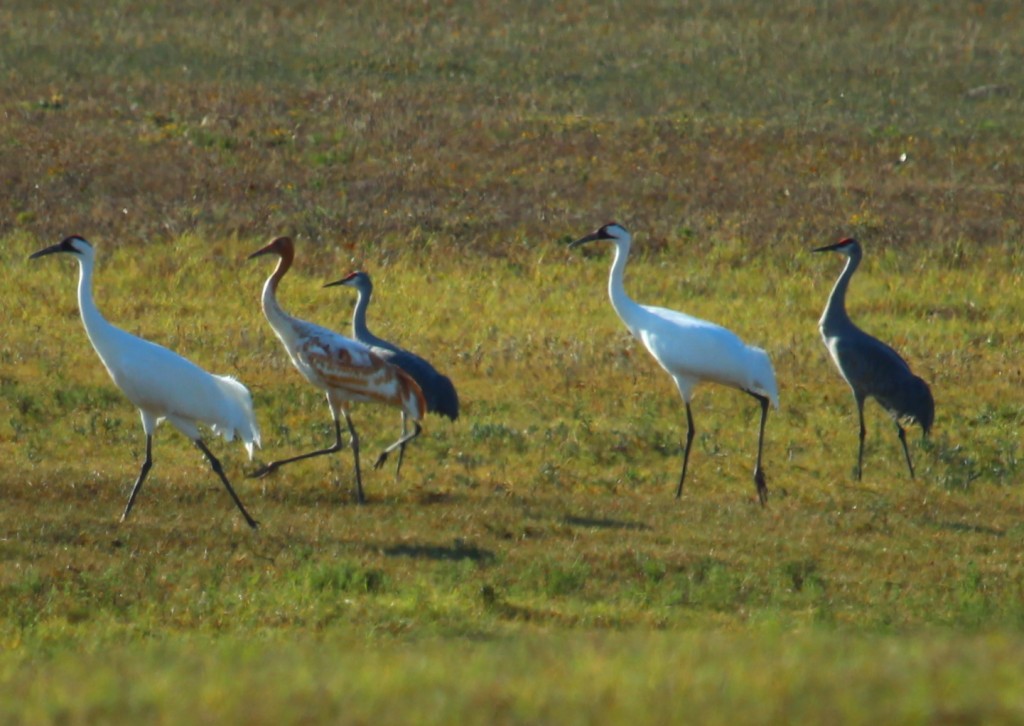
Two adults and one juvenile whooping crane with two sandhill cranes, Rock Port, Texas.
Photo by: Peggy Diaz
The best place to see whoopers is when they reach their winter habitat at Aransas National Wildlife Refuge along the Texas coast. You can ride along refuge roads and see some in fields and marsh land. Or you can climb the new tower on the Refuge and observe whoopers over a vast marsh area. But possibly the best way to observe them is to get on one of the commercial boats at Rockport, TX and ride out to make your observations.
Whooping Cranes Continue Migration South
October 27, 2012By Chester McConnell, Whooping Crane Conservation Association
Whooping cranes are on the move southward and have been spotted all along the migration pathway. The Whooping Crane Conservation Association has received reports of cranes along their migratory path from Saskatchewan, Canada to Aransas, Texas.
Martha C. Tacha, U.S. Fish and Wildlife Service, Nebraska reports that, “The whooping cranes with GPS transmitters are on the move, with the bulk of these marked cranes in North Dakota and South Dakota, and two already in Texas. We know that one unmarked whooper stopped over at a lake near Oklahoma City recently. While the early confirmed sightings have been single birds, there was a group of nine adult-plumaged whoopers in northern North Dakota recently.”
One of the GPS transmitter marked whooping crane arrived on the Texas coast on October 18 and has been using the marsh habitat extensively. Aransas National Wildlife Refuge officials report that, “All other GPS marked whooping cranes are north of South Dakota awaiting favorable migration conditions. Biologists expect the cranes will take advantage of the strong north winds associated with seasonal cold fronts. On October 23 Aransas Refuge Biologist Brad Strobel and Refuge Manager Dan Alonso observed one adult whooping crane feeding in the refuge marshes on the Blackjack peninsula. The bird ate at least two prey items during the 3-5 minutes it was observed.
The winter home of the whooping cranes at Aransas Refuge is improved compared to this time last year. Refuge personnel advise that salinity levels in the bay waters are fresher than they were at this time last fall and winter. The salinity levels in San Antonio Bay were recorded as 23.9 parts per thousand.
Aransas Refuge also has experienced improved rainfall in recent months. According to refuge officials, to date, the refuge has received 25.6 inches of rain, which is a foot more than we had last winter at this time. The area is still unusually dry but the National Oceanic and Atmospheric Administration predicts south Texas will see a wetter than average winter and spring in 2013. To make certain freshwater is available to the whooping cranes when they arrive, refuge staff have been working on water well sites previously used by cranes on the Blackjack peninsula to ensure they are in good working condition.
Whooper food sources on the refuge have also improved during this growing season. Refuge biologists have noticed many flowering and budding wolfberry plants while conducting field work during the last few weeks. Wolfberry conditions in the marsh appear to be much better than this time last year. Peak berry abundance typically occurs in November and December and the plants seem to be on schedule according to biologists. Blue crabs also appear to be abundant in the marsh currently based on surveys conducted by refuge personnel.
TAP Urges Attendance at Whooping Crane Count Meeting
October 22, 2012by Ron Outen, Regional Director, The Aransas Project
The U.S. Fish and Wildlife Service will hold a second Public Meeting at Aransas National Wildlife Refuge on Wednesday, October 24th. The public is urged to attend to learn about the Service’s new method to count whooping cranes.
It was truly gratifying to see the great outpouring of support for and interest in the whooping cranes from the Rockport community at the October 4th presentation by USFWS on the new distance sampling methodology being used at Aransas National Wildlife Refuge. The questions asked by the audience demonstrated again that the Aransas-Rockport area is one of the most knowledgeable and engaged communities anywhere, especially when it comes to the whooping crane.
We hope that folks who attended that first public presentation, as well as others who may have been unable to attend, will attend a second public presentation being offered by USFWS: 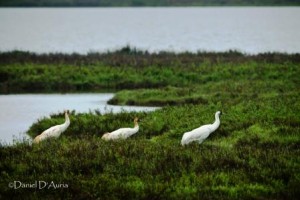
Wednesday, October 24, 2012
6 to 8 p.m.
Aransas National Wildlife Refuge
(six miles south of Austwell on Farm-to-Market Road 2040)
Because USFWS issued its Aransas-Wood Buffalo Whooping Crane Abundance Survey (2011 – 2012) only one day before the October 4 briefing, this is a great opportunity to ask further questions of Aransas Refuge staff after having had more opportunity to review the report, or simply to ask questions that you didn’t get a chance to ask last time.
Video of October 4th presentation Available Online:
The Aransas Project has posted a video documenting the two-hour public presentation by the U.S. Fish and Wildlife Service on the distance sampling methodology in use at the Aransas National Wildlife Refuge during the last wintering season. The presentation was held on Oct. 4, 2012 in Fulton, and includes the formal presentation as well as questions from the audience following the presentation. While there was a great crowd on hand with many well-informed questions, we know that many people were not able to attend. We hope that this video documentation is helpful to the whooping crane community around the world in staying informed on this critical issue.
As you can see in the next article below, the defendants in TAP’s litigation have sought to supplement the record with USFWS’ Oct. 3 report, which is critical of Stehn’s methodology. We think that you will find that the tone of the presentation captured in the video differs significantly in its characterization of Stehn’s work from that of the written report released by USFWS one day prior to that public meeting. It also gives you a great sense of the strong level of public engagement on this issue.
Defendants Seek to File USFWS Report in TAP Litigation:
Judge Will Not Admit Without Full Evidentiary Hearing to Probe Credibility
As reported recently by Matthew Tresaugue of the Houston Chronicle, TAP supporters should also be aware that the State of Texas, the Guadalupe-Blanco River Authority and other defendants have sought to introduce USFWS’ Oct. 3 report into evidence more than 9 months after the close of the trial in TAP’s lawsuit under the Endangered Species Act. The Oct. 3 report criticizes the previous census method and introduces USFWS’ new statistical modeling method of estimating peak flock size. The previous census method was used since 1982 by USFWS’s own prior Crane Coordinator, Tom Stehn. Stehn’s work led the recovery and survey of this species until he retired in September 2011.
The federal district judge presiding over the case has indicated that the report will not be admitted into evidence without a full evidentiary hearing at which the authors of the report from USFWS are available would be required to testify. Read more about this development.
Crane Migration Back to Texas Coast Underway:
All of us who love the cranes are excited that the annual migration back to the Texas coast from the summer nesting grounds in Canada is underway. In a blog post entitled, “Whooping Cranes Migrating South to Texas” https://whoopingcrane.com/whooping-cranes-migrating-south-to-texas/ , Chester McConnell of the The Whooping Crane Conservation Association reports that the cranes had a successful summer nesting season. Check out Chester’s post to learn more about estimates on the number of cranes expected to arrive at the Refuge.
The Victoria Advocate Editorial Board also issued an editorial on the return of the cranes, encouraging residents to visit the Refuge to see the cranes and noting significantly that:
In a way, the cranes are protecting us as well. Their protected status limits the amount of water that can be taken from the rivers feeding into the refuge in order to maintain the correct balance in the estuary that houses the cranes’ major food source. While this may be an inconvenience for some area industries, it ultimately protects our waters from being siphoned away from our area, keeping it here to meet the needs of area residents and wildlife.
While all of us in the Coastal Bend need no reminder of the critical link between our well-being and that of the cranes, it is encouraging to see this message from the Advocate’s Editorial Board.
Thanks so much for your continued support. Please feel free to forward this on to a friend.
Nesting Success Good For Whooping Cranes In 2012
October 8, 2012by Chester McConnell, Whooping Crane Conservation Association
Whooping crane nesting success on Wood Buffalo National Park, Canada during 2012 was considered good but slightly down from previous years. This is good news after the poor winter season on Aransas National Wildlife Refuge in Texas.
Sixty six (66) whooping crane nests were discovered in May by the CanadianWildlife Service. Three months later in August, an additional three (3) family groups were identified indicating that there were at least sixty-nine (69) nesting attempts during the2012 nesting season. In early August, just prior to fledging, thirty-four (34) young were observed on the breeding grounds. Two (2) sets of twins were observed. Ten of the young whooping cranes were marked with leg bands and satellite transmitters.
Martha Tacha, U.S. Fish and Wildlife Service reports that: “The whooping cranes began moving down into staging areas in Saskatchewan last month; a week ago about half of the GPS-marked cranes were in Saskatchewan. There are currently 30 whooping cranes carrying working GPS transmitters, and likely a hand-full of marked cranes with colored leg bands from 1978 to 1988 marking effort. As of this morning (Oct.5), there were no GPS-marked cranes in the United States except for one young whooper in Burke County, in extreme northwest North Dakota (this bird was also observed independently by biologists on the ground on and after September 22, 2012). However, I have also received confirmed, probable, and several unconfirmed reports of whooping cranes observed as far south as southcentral North Dakota, so apparently at least one or two whooping cranes without GPS transmitters have moved farther into the northern reaches of the U.S. Flyway.” Citizen birders have also reported to the Whooping Crane Conservation Association of their observation of whooping cranes in Saskatchewan and North Dakota.
The Whooping Crane Conservation Association is hopeful for a much better winter season on Aransas Refuge. As most whooping crane interests know, last winter on the refuge was abnormal in several respects, including severe drought conditions and poor food availability. Some of the cranes spent some or all of the winter away from Aransas making accurate counts of the birds impossible. During the past several months, the Aransas area has received more rain and habitat conditions are improved. Blue crab numbers have rebounded along the Aransas Refuge coast and the returning whooping cranes will, at least, start out with a good food supply. Hopefully the wolfberry crop will improve and be another source of food.
The retirement of Tom Stehn last year resulted in a change from a direct count method to a transect-based survey of the greater Aransas NWR area to estimate the number of whooping cranes wintering there. Therefore, the official estimate of 254 whooping cranes wintering at Aransas last winter is not comparable to previous years’ estimates of flock size. There was much optimism that a record three hundred (300) whoopers would be counted on Aransas Refuge in 2012, but due to the unusual movements of the cranes and the new census method, the accurate number will never be known. Hopefully, this winter will be more typical in terms of crane distribution and Aransas Refuge biologists will be successful in making an accurate count.
TAP Concerned About Whooping Crane Survey Methodology Changes
October 4, 2012by Ron Outen,
REGIONAL DIRECTOR, THE ARANSAS PROJECT
The Aransas Project (TAP) leaders announced their concerns about the U.S. Fish and Wildlife Service’s proposed new whooping crane survey methodology. TAP is urging its members to attend a critical public meeting being hosted by the Aransas National Wildlife Refuge to address the changes being made in the survey methods used to count the endangered whooping cranes that winter at the Refuge. Beginning in the winter of 2011-2012, U.S. Fish & Wildlife Service (USFWS) altered its methodology for tracking how many cranes are in the flock and this will be the first public meeting providing any insight or explanation of their methods. In July 2012, TAP released our State of the Flock 2011-2012 report, documenting concerns with the methodology as well as how the flock fared in Winter 2011-2012.
TAP members are strongly encouraged to attend to remain informed on this critical issue:
Thursday, October 4, 2012
6 PM to 8 PM
Paws and Taws Convention Center
402 North Fulton Beach Road Fulton, TX 78358
According to a USFWS news release, the presentation “will investigate and define aerial survey methods used historically and currently to count the Aransas-Wood Buffalo flock of whooping cranes.” Refuge Biologist Brad Strobel will lead the presentation, and there will be a Q&A session following the presentation.
October 3, 2012: USFWS Posts Report
On October 3, the eve of their public meeting in Fulton, the USFWS has posted to their website a report that they titled,“Aransas-Wood Buffalo Whooping Crane Abundance Survey (2011-2012)”. The report states that its first objective is “to share information in a timely manner;” however, the report was promised by August and was posted October 3, one day in advance of the public meeting noted above.
The report primarily focuses on criticizing the previous census method and introducing their new statistical modeling method of estimating peak flock size. The previous census method was used since 1982 by USFWS’s own prior Crane Coordinator, Tom Stehn. Stehn’s work led the recovery and survey of this species until he retired in September 2011.
Given the timing of the release of this report, TAP’s review has identified, at a minimum, a number of issues of concern:
Territoriality: The report states that, “[the] assumption of territoriality is unnecessary and untenable given recent data.” This conclusion is stunning, and flies in the face of the established scientific literature, decades worth of banding data, and earlier GPS tracking data. This conclusion appears to be based solely on one year’s GPS tracking data that was collected in a year when the cranes were clearly dispersed due to severe drought.
The End of Crane Counting?: Because the new method is designed to statistically estimate only peak flock size, it appears that USFWS no longer intends to track or tell the public how many cranes are in the flock, or how many cranes die at Aransas in any given year.
Basis and Data for New Peak Count Unclear: In contrast to the previous method that clearly counted and reported the number of cranes, the new statistical style instead counts some cranes and then estimates the peak flock count, a number that is buried in pages of complex statistical lingo. Additionally, because USFWS does not share the underlying raw data, it is difficult to determine how a new peak flock estimate of 254 birds was derived.
These are only a few of the questions that are prompted by this report, and TAP is concerned that the report was not provided further in advance of this public meeting to allow full analysis by researchers and the public. We hope that USFWS will be able to shed additional light on the reasoning and conclusions reached in the report in light of the concerns expressed above.
Young Whooping Crane In Capture Project Dies
September 3, 2012 |
|
Young whooping cranes, 31 in all, have been banded with transmitters for three summers in their summer Wood Buffalo National Park habitat. (Photo: Courtesy of Parks Canada)
|
A juvenile whooping crane has died, possibly from a self-inflicted wound suffered trying to escape capture in Wood Buffalo National Park. The bird was to be banded as part of a program attaching radio transmitters to juvenile cranes. The carcass has been shipped to the Canadian Cooperative Wildlife Centre in Saskatoon for autopsy.
“We don’t know the cause of death. The crane was injured. It may have happened as part of the capture process,” Stuart McMillan, Wood Buffalo National Park manager of Resource Conservation told The Journal.
Crews land in a helicopter and try to round up the young birds, which naturally run away. McMillan said cranes are known to scratch themselves while running.
The bird was seen to be injured after it was captured for the banding process. A veterinarian is part of the capture crew and the young bird was examined immediately, treated with an antibiotic and released. It returned to its parents and things seemed normal. Some time later, the signal from the transmitter stopped moving. On investigation, the bird was found dead.
“It is certainly disappointing. We didn’t want to have a result like this. We want to find out what happened to prevent it from happening again,” said McMillan.
He said if the cause of death is from the capture process they will study it and make changes to procedures to minimize the risk of it happening again.
The banding exercise, called “telemetry,” is a joint Canada-US project. Thirty one juvenile cranes have been outfitted with transmitters over the last three years without incident.
Migration routes, habitat sought during migration, food sources and threats cranes face are just some of the information the project hopes to gather. The data is still preliminary, and it is too early to draw conclusions.
It is known that whooping cranes often stop in the same places year after year as they come and go annually between Aransas Wildlife Refuge in Texas and Wood Buffalo National Park in the NWT. In some places where they are known to stop each year, people gather to watch for them. It is hoped that public awareness can be raised once more is learned about where and when they stop.
One thing being investigated is the impact of power lines. Dead cranes have been found in the vicinity of power lines but no one knows why. Some speculate lines should be marked along the migration route and that new lines planned in those locations be erected at different sites. One benefit of the radio transmitters is that a dead bird can be found right away.
“When a crane dies it is best to look at an intact carcass to determine the cause of death, not one decomposed or torn apart by scavengers. If banded with a transmitter which stops moving, we can go look for the bird right away,” said McMillan.
This winter, adult birds will also be captured and banded at the Aransas Wildlife Refuge.
State of The Whooping Crane Flock 2011-2012
July 9, 2012by The Aransas Project
July 9, 2012: The Aransas Project (TAP) prepared this State of the Flock 2011-2012 report to provide critical information to our members and to the public regarding the well-being of the Wood Buffalo-Aransas Whooping Crane flock after the 2011-2012 wintering season.
Whooping Crane Flock Numbers Plunge during Winter 2011-2012
A recent news release issued by the Southwestern Region of the United States Fish and Wildlife Service (USFWS) confirms that the winter of 2011-2012 was one of the worst winter seasons in Texas for the Wood Buffalo-Aransas flock, the last remaining natural flock of Whooping Cranes that winters at Aransas National Wildlife Refuge (see Figure 1).
USFWS official reports put the flock size at the end of the previous winter of 2010-2011 at 279 cranes. In the winter of 2011-2012, on the aerial surveys in late January 2012, USFWS counted only 193 birds and then used statistical methods to extrapolate from that number an estimated flock size of 245. This statistical estimate represents a decrease in flock size of 12.2% from the previous winter. This represents one of the largest declines in flock size ever recorded.
Despite these facts, USFWS officials have made several public statements, including “The flock is so large they can’t count individual birds,” that paint an overly optimistic, and ultimately misleading, portrait of the state of the Aransas-Wood Buffalo flock.
“The recent statements attributed to USFWS leave the public with the impression that the flock numbers are up,” says TAP legal counsel Jim Blackburn. “Yet, according to their own official reports, there are fewer birds. Any way you do the math, 245 is less than 279.”
Based on the aerial survey in late February 2012, USFWS reports that the flock size was estimated to be 196, notably less than the previous estimate of 245.
“Recent public statements by USFWS officials at the Refuge paint a rosy picture of the health of the flock when the scientific record says otherwise,” says Blackburn. “The facts are these—the size of the flock, even by USFWS’ own estimation, is lower than during the prior year, and the scientific record from electronically-monitored cranes in the flock suggests more cranes may have died than in the drought of 2008-2009, which was the highest mortality ever recorded. But we’ll never know what really happened, because USFWS has abandoned the methodology of counting individual cranes each month, as was done for 29 years, and instead has resorted to distance sampling of the birds, from which they then statistically extrapolate to provide an estimate of the flock size.”
USFWS Methodology Faulted
Beginning in the winter of 2011-2012, USFWS altered its methodology for tracking how many cranes are in the flock. “Every year but this year for 29 years, the former refuge biologist, Tom Stehn, did monthly flyovers during the wintering season and methodically counted every crane on the refuge, using both territories and defined transects to identify the birds,” says Blackburn. “This year the refuge didn’t do a census to count the cranes as they have every other year, but instead used a sampling method and also decreased the frequency of the flights.” Blackburn says TAP believes this methodology to be less reliable.
Stehn himself questioned the validity of the USFWS sampling methodology in a recent interview with the Corpus Christi Caller-Times. In the interview, Stehn noted that the current sampling methodology used by USFWS, known as “distance sampling,” has an error range of 15%, which Stehn believes is far too high when dealing with a population of fewer than 300 endangered cranes.
Stehn told the Caller-Times, “I’m really frustrated and disappointed with the changes in the census the refuge has made. It’s simply not accurate enough when you’re dealing with such a small population of endangered birds.”
Stehn noted that the aerial census methodology he employed for nearly 30 years used flyovers on a much tighter grid and allowed him more flexibility to conduct more thorough searches off the search grid.
USFWS has cited the growing number of cranes in the flock as its justification for resorting to a sampling and estimating approach, rather than actual counting. Blackburn comments, “We don’t really understand that, because Tom Stehn seemed to manage just fine with more cranes. Recent statements by USFWS would make you think that they were covered up in cranes down there, which even their estimates don’t support.”
Tracking Data Suggests Unprecedented Crane Mortality
Recent statements by USFWS also create the impression that the number of cranes that died this past winter was far less than during the drought of 2008-2009 because fewer crane carcasses were found. A recent sworn statement filed by Whooping Crane expert, Dr. Felipe Chavez-Ramirez, the principal investigator in an ongoing research project electronically tracking 31 cranes in the Aransas flock using GPS bands, suggests that crane mortality may actually be higher than USFWS reports indicate.
According to Dr. Chavez-Ramirez’ statement:
- The carcasses of three juvenile cranes were recovered during the 2011-2012 wintering season
- Out of the 31 banded cranes, this is a mortality rate of 9.6%
- Out of the ten banded juvenile cranes, the mortality rate is 30%
- The documented mortality rate of 9.6% in this monitored subgroup of birds is “unprecedented” and exceeds the previous high mortality rate of 8.5% during winter 2008-2009
Blackburn says this scientific evidence suggests that more cranes may have perished due to the drought in 2011-2012 than in the prior drought of 2008-2009. “It seems like USFWS is sticking their heads in the sand down there in terms of the health of the flock,” says Blackburn.
Conclusion
The Aransas Project continues to seek responsible water management of the Guadalupe River Basin to ensure adequate freshwater inflows to the bays and estuaries that provide the winter habitat for the endangered Whooping Cranes. Until this problem is addressed, the future health of the bays and estuaries and of the Whooping Cranes will not be secure. “What we need, and should expect from USFWS, is a clear-eyed, scientific view of the state of the flock,” says TAP Regional Director Ron Outen. “TAP feels that residents of the Coastal Bend and the broader public need to know what is happening down here. We hope that it contributes to a better understanding of this critical and ongoing issue for the state of Texas.”
Leave a Comment
Whooping Cranes on Aransas and Private Lands
March 1, 2012Whooping crane aerial census surveys were completed a second time on Aransas Refuge in February. But analysis of the information is not yet complete. According to refuge officials the February aerial survey has had some challenges due to weather but they are continuing their efforts. The updated census information will be posted on the website as soon as it becomes available. Meanwhile the interested public must rely on the January survey information that indicated the population of cranes to be 245 individuals. Aransas officials caution that this number does not reflect whooping cranes outside the survey area, including those that have dispersed. Whooping crane biologist and many thousands of whooper followers have been hoping for a total population count of 300 this year.
The unusual warm weather and extreme drought conditions in Texas are believed to be a primary cause for the dispersal of whooping cranes this year. Normally the birds remain mostly on Aransas National Wildlife Refuge during winter months with a few moving to nearby suitable locations. This year, however the whoopers are ranging further out from the refuge with some as far north as Nebraska. Citizen observation reports made to the Whooping Crane Conservation Association detected whoopers in Nebraska, Kansas, Oklahoma and eight counties in Texas.
- Figure 1. Whooping cranesmaking use on private land in Texas.
Some good news is that, as of February 29, the precipitation totals for Aransas, TX are 3.75 inches. Also, heavy rains north of the Aransas Refuge brought much fresh water downstream to the bays and estuaries near the refuge. Salinity levels in San Antonio Bay are recorded as 20.4 parts per thousand. Salinity levels have dropped due to recent freshwater inflows from rain in Central Texas, as well as localized rainfall.
Since the last Aransas Refuge update, the refuge has conducted additional prescribed burns bringing the total to 10,852 acres of habitat. The whooping cranes have been observed eating the roasted acorns and other food sources. There are still approximately 1,110 acres planned for the remaining whooping crane season. The refuge had originally hoped to burn approximately 14,200 acres but weather conditions prevented firefighters from safely and effectively conducting the prescribed burns to help alleviate low food sources for the cranes.
